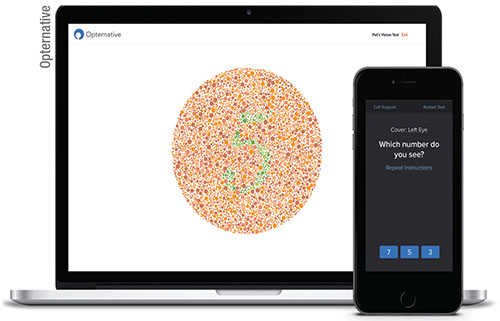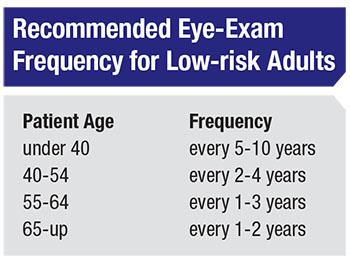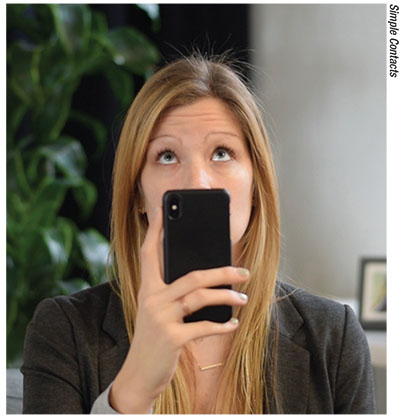Ordering glasses or contact lenses online is not new, but renewal of the script has traditionally entailed a trip to the ophthalmologist or optometrist for a dilated eye exam. Some doctors say that this office visit is needlessly burdensome for a large proportion of patients, who would benefit from the ease and cost-effectiveness of telemedicine. Online vision testing’s advocates seek to spread the word about a service they say offers a safe, quick and affordable alternative to in-office visits. Other providers, however, vehemently oppose what they consider a dangerously incomplete eye-care paradigm.
 |
| The online vision tests discussed here are examples of asynchronous telehealth apps, where the patient takes a test and then an eye-care professional evaluates the patient’s responses or video recording remotely before renewing or issuing a prescription. Shown here: a color-vision item from Opternative’s online vision test. Patients respond to prompts on the computer screen by entering answers using a smartphone. |
Although some online vision tests involve real-time interaction with an eye-care provider, many exemplify “store-and-forward,” or asynchronous, telemedicine, wherein the provider reviews stored data after the patient completes testing. The online-glasses giant Warby Parker (New York) launched its app, Prescription Check, in 2017 to allow existing customers to renew their spectacle prescriptions. (Representatives from Warby Parker were not available for comment at press time.)
Opternative (Chicago) founded in 2012, lets users renew or get updated scripts for glasses, contacts or both. Simple Contacts (New York), founded in 2015, offers a vision-test app called Rx Renewal to check contact-lens prescriptions only.
“Telemedicine could create a lot of different ways of reducing inefficiency in the U.S. health-care system,” opines Saya Nagori, MD, medical director of Simple Contacts. “In the case of contact lenses, 80 percent of the time you end up getting the same prescription you came in with. But you still have to pay for the doctor’s visit and schedule time out of your day.”
Steven Lee, OD, founder and chief science officer for Opternative, says that patients should be able to do more than confirm existing prescriptions remotely. He says that his company’s online refraction testing “is the only one on the market that allows patients to receive a prescription for glasses and/or contact lenses, even if the prescription has changed.
“We are aware that online refraction is only one component of a person’s overall eye health,” Dr. Lee notes. “Because of this, we recommend that all patients go through a full eye exam with an eye-care professional at least once every two years.” All three of the above vision-testing apps have language cautioning that their services are not intended as a substitute for a comprehensive eye exam, and they stress that ophthalmologists or optometrists evaluate the self-administered testing’s results. Warby Parker’s Prescription Check app cautions would-be patients, “The app will guide you through a series of tests to figure out how you’re seeing through the prescription eyeglasses you’re wearing. An eye doctor will assess your visual acuity, but Prescription Check isn’t meant to replace a comprehensive eye exam and we aren’t checking your eye health.”
 |
| This table shows the recommended frequency of comprehensive medical eye examinations for healthy adults with no risk factors for eye disease, per guidance from the American Academy of Ophthalmology.1 The online vision-testing apps discussed here emphasize that their services are not intended as a substitute for a comprehensive exam by an eye-care professional. |
Simple Contacts founder and CEO Joel Wishkovsky thought it was “baloney” when he was directed to go get a comprehensive eye exam to renew his contact-lens prescription. His workaround (getting an ophthalmologist friend to renew his prescription based on his answers to health questions, video checks for redness and to demonstrate that he could read to 20/20 on an eye chart) inspired him to get into the telehealth market. “I immediately thought, ‘I can build this into an app. I can build a website around it,’” he recalls.
Using a smartphone or computer, patients submit secure videos for ophthalmologist review after they answer some health-history questions, including when they had their last dilated eye exam. “The redness test is a video eye exam. We ask users to look left, right up and down, looking for any eye irritation and any kind of redness,” Dr. Nagori explains. “There’s a built-in zoom feature on the administrative side, so as a doctor, I have the ability to zoom in much closer than the patient actually takes the video. The second part is a distance-calibrated Snellen chart, so the iPhone or Android is able to tell how far you are from the phone/camera and when you should initiate the vision test. That’s done at 10 feet. We only renew patients who are able to read the 20/20 line in their contacts.”
Mixed Reactions
Online vision tests have gotten a mixed reception from professional eye-care associations, and there’s a wide gulf in acceptance between ophthalmologists and optometrists. “We’ve raised 30 million dollars, and a lot of that comes from ophthalmologists, not just from venture capitalists,” says Mr. Wishkovsky. Dr. Nagori concurs that fellow ophthalmologists are supportive.
The American Optometric Association, however, stands in firm opposition to online vision testing on the grounds that patients may be misled into believing that they’re getting more health care than a simple verification of their vision prescription. A statement provided to Review of Ophthalmology from the American Optometric Association reads in part, “While there may be fine-print disclaimers that say these apps do not replace comprehensive eye examinations, consumers may still be under the impression they have received medical eye care.”
The statement concludes with a warning: “Existing vision apps promise health care, but they deliver much less than the medically recognized standard of care. Through an in-person, comprehensive examination, doctors of optometry assure precise and healthy vision, identify and treat diseases such as dry eye, macular degeneration and glaucoma as well as ensure early diagnosis of immediate threats to overall health, including hypertension, stroke and diabetes, which may have no obvious signs or symptoms.
“The AOA will continue to hold companies accountable for any claims they make that potentially put consumer health at risk.”
In 2016 the AOA sent a strongly worded complaint letter to the U.S. Food and Drug Administration in which they alleged that Opternative was using its app in such a way that its testing constituted a novel medical device, without submitting a premarket application. The FDA subsequently issued a warning letter to Opternative that enjoined it to “immediately cease activities that result in the misbranding or adulteration of the On-Line Opternative Eye Examination Mobile Medical App device, such as the commercial distribution of the device through your online website.”2
Dr. Nagori says that her company’s testing incorporates a Snellen eye chart with the sole purpose of determining visual acuity—not to calculate a new prescription. “We’re currently operating in 42 states. We’ve created a very comprehensive exam that’s very safe, and we took the strictest state’s requirements and applied them to all the states where we operate when devising our tests. That way, we don’t have any regulatory issues at the state level. In the case of ophthalmologists, refractions and contact-lens renewals are probably among the most benign things we do in the office; and I, along with several other ophthalmologists, have worked together to make sure we comply with the American Academy of Ophthalmology’s clinical guidelines. We feel that this test is extremely comprehensive for its purpose—which is for contact-lens renewals only,” she says.
Dr. Nagori adds, “There’s a healthy amount of research supporting the idea that lack of an easy way to renew your contact lenses is a factor in contact-lens-related infections. An app like ours, which prevents patients from using their lenses for too long, can actually help to prevent those issues, because one of the biggest reasons patients don’t renew their contact lenses on time is that they just can’t get in to see the doctor, or because of the expense. Creating telemedicine solutions improves access and also makes it affordable.”
The American Academy of Ophthalmology has taken an official stance of conditional openness to online testing. “The Academy is generally supportive of the use of new technologies to improve efficiency and widen access to eye-care services. These technologies can help make diagnostic tools more available in remote settings, enabling remote diagnosis and interpretation. They can also help reduce health-care costs and visits,” its statement reads in part. “But, as with any new medical technology, online vision testing needs to be evaluated over time for safety and efficacy.”3 The AAO’s guidance does diverge from Simple Contacts’ inclusion criteria with regard to patient age, stating, “These services may be appropriate for people 18 to 39 years of age with non-severe corrective eyeglass prescriptions and no symptoms of eye disease.”3 Simple Contacts does not have an upper age limit for users. The Academy also noted that it had “insufficient data” about online prescription renewal specifically for contact lenses at the time it issued guidance about online vision testing in general.
 |
| The online testing services discussed here emphasize that they are not providing the equivalent of a comprehensive eye exam, but they do have basic mechanisms to screen out patients in poor ocular health. Shown: patient using the redness-check portion of the Rx Renewal app. |
Dr. Nagori says that patients must be aged 18 or older with no major medical issues to use the Rx Renewal app. “They can’t have hypertension or diabetes, for example,” she says. “While those conditions affect the back of the eye and have little to do with contact lens wear, we want to encourage those patients to go in to see the doctor. At this juncture, we feel that we should push them into the doctor’s office. If you’re healthy and free of medical issues, and you’ve had a dilated eye exam within the time frame that the AAO recommends, then you’re to use online prescription-renewal testing,” she says.
Dr. Nagori estimates that about 500,000 patients have used Rx Renewal. “It’s hard to tell how many people have gotten a script, because we do have some failures, which probably constitute about 8 to 10 percent of the people using the app,” she says.
She adds that the failures help ensure safety. “The first broad screening is a questionnaire for issues that could affect eye health,” she says. “But, sometimes if wenotice something incidentalthat is not really immediately harmful, like a stye that doesn’t look like it’s at risk of turning into a cellulitis and looks pretty benign, we may give a limited renewal for a month or two and then recommend that they go to see a doctor to get that issue addressed. Sometimes, the things that trigger a fail are more serious: for example, an unusual eye movement that concerns me. I obviously can’t examine them, so I’ll suggest that they see a doctor instead. Even though that’s not directly related to their use of contacts, I still want to motivate them to go in and see the doctor. Sometimes, fails are related to possible effects of contact-lens wear. So if a patient’s eye appears red or irritated, we don’t allow them to renew. They may also fail the vision test. Some patients think that they’re seeing clearly when they’re actually not able to read the eligible 20/20 line: That’s another reason we would send them back to their doctor to have their prescription refined and adjusted,” she says.
In the case of a failure, the patient receives a notification instead of a renewed script. Mr. Wishkovsky says that the company facilitates communication with the reviewing ophthalmologist. “We have a mechanism that allows the doctor to call the patient,” he says. “The patient can also call the doctor. Or they can have a conversation via text message. In most of these situations, the doctor sends instructions advising them of what they’ve detected and telling them they should see a doctor in person. Our team can work with that person to find them an appropriate provider in their area.”
Future Advances?
Opternative’s Dr. Lee emphasizes that online refraction technologies are not particularly novel, and he thinks they’re safe when offered with care. “The technology has been tested with hundreds of thousands of patients receiving accurate prescriptions since 2015,” he says. “The technology checks various components of a patient’s prescription in a number of different ways to ensure that the prescription has been accurately measured. Additionally, all refractive-error measurements are reviewed by an eye-care professional before a patient is issued a new prescription.”
Mr. Wishkovsky thinks that as online refraction gains ground, the model is readily applicable to other health-care contexts, such as remotely renewing birth-control prescriptions in healthy, low-risk patients. Dr. Nagori says that the company is already at work on adding specialty-specific features to Rx Renewal. “Right now we’re working on developing an AI system that risk stratifies patients found by the test to have red eyes. We want to find solutions that will alleviate not only issues for patients, but also unburden some of the health-care system where possible. With risk stratification, instead of waiting in the ER for four or five hours, a patient with a red eye could be triaged faster if an artificial intelligence system could predict the likelihood of needing to see an eye doctor immediately, versus the likelihood of something being a condition that could wait until the next morning, for example.”
As a glaucoma specialist, Dr. Nagori thinks that telemedicine could benefit both patients and providers outside of the direct-to-consumer space. “In glaucoma, I think a lot of the tests are things that patients could do at one location, but that could be read remotely by a physician,” she says, adding that she believes adoption of telehealth monitoring in glaucoma will take a while, since such visits are necessarily much more frequent than dilated eye exams.
She also thinks that some postoperative exams could one day take place remotely. “Elderly patients could benefit—populations such as cataract surgery patients, or those who undergo lid surgery for purely functional ptosis,” says Dr. Nagori. “It’s hard for them to come back into the office repeatedly. There are a few appointments that obviously would be crucial, but maybe fewer than we currently think. Maybe after the first or second in-person postop visit, we could offer a telehealth solution that could allow some of the more elderly patients a chance to complete some of their postop visits remotely, provided they had uncomplicated surgery and they were going in the right direction on postop day one and postop day seven. Those are solutions that we haven’t built out yet, but we intend to keep looking at this space in health care.”
Dr. Lee also thinks that ocular telemedicine can go beyond online refractions. “Opternative is working on other telemedicine innovations surrounding eye health, including methods of monitoring glaucoma and macular degeneration on a more consistent basis,” he says.
At the 2018 American Society of Refractive and Cataract Surgery meeting last spring in Washington, D.C., Dr. Nagori was a keynote speaker on the future possibilities of telemedicine. She says she’s optimistic that online vision testing is just the beginning in ophthalmology and other specialties.
“We risk stratify in every other field of medicine,” she notes. “Not everyone needs a Pap smear every year; not everyone starts getting their colonoscopies at 40. We should be risk stratifying in ophthalmology as well. We should allow those patients who are on the safer end of the spectrum to do certain things from the convenience of their homes, and we should find solutions that are not only more accessible, but also more affordable. As long as it’s safe, I think patients should have the freedom to make choices in their health care.” REVIEW
1. AAO PPP Committee, Hoskins Center for Quality Eye Care. Comprehensive adult medical eye evaluation—2015.Avalilable at https://www.aao.org/preferred-practice-pattern/comprehensiveadult-medical-eye-evaluation-2015. Accessed July 19, 2018.
2. U.S. Food and Drug Administration. Warning letter, Re: On-line Opternative eye examination mobile medical app device. October 30, 2017. Available at https://www.fda.gov/iceci/ enforcementactions/warndngletters/2017/ucm600029.htm. Accessed June 29, 2018.
3. American Academy of Ophthalmology. American Academy of Ophthalmology provides information to the public on online vision testing for corrective eyeglass prescriptions. September 22, 2015.Available at https://www.aao.org/newsroom/news-releases/detail/american-academyof-ophthalmology-provides-informa. Accessed July 3, 2018.



